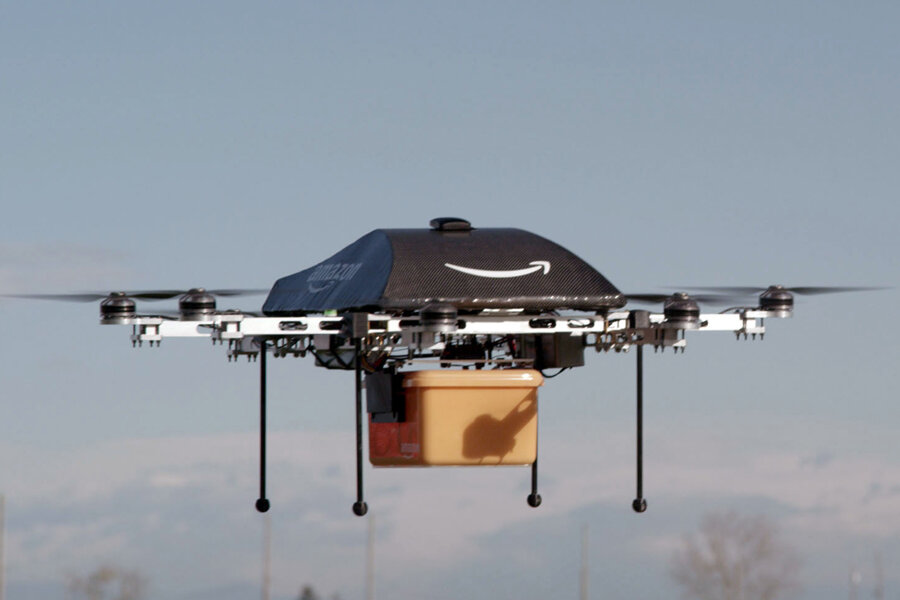Amazon plans drone delivery. Will Feds approve?
Loading...
Amazon CEO Jeff Bezos on Sunday said his firm is working on ways to deliver small packages via drones. That’s right: Amazon “Prime Air” may eventually have thousands of robot flying machines buzzing through neighborhoods across America, dropping off everything from shoes to consumer electronics.
At least, that’s the vision Mr. Bezos outlined on “60 Minutes.”
“It will work, and it will happen, and it’s gonna be a lot of fun,” he told correspondent Charlie Rose.
Well, we would not wager against Amazon, given its relentless march toward US retail dominance. And it’s easy to see how the concept would work, in a technical sort of way: Small "octocopter" unmanned aerial vehicles (UAVs) capable of carrying five pounds or so already exist.
The “fun,” however, may be in the eye of the beholder. In urban areas, swooping octocopters might seem a hazard, pigeons with gas-powered propellers. In rural areas, they might be targets for people bored of hunting deer.
“Amazon fine print: ‘Drone delivery unavailable outside urban areas during hunting season,’ ” RedState's Erick Erickson tweeted on Monday.
And the real problem here might be the Feds. The Federal Aviation Administration is working to integrate civilian drones into US airspace. That’s unlikely to be a speedy process. Amazon’s realistic drone-delivery start date might be 2025 or beyond.
That’s if Amazon can satisfy the FAA’s safety concerns at all. The Amazon concept brings drones into closer contact with people than other civilian UAV uses currently under FAA study. Will it be possible to avoid packages dropped from a hundred feet up, buzzing drones snagged on power lines, out-of-control drones plummeting into bedroom windows? Plus, what about privacy and national security concerns?
“The safe integration of unmanned aircraft into the [national airspace] is a significant challenge,” the FAA notes in the conclusion of its road map for approval of civilian drone use.
Of course, civilians already fly drones in America. They’re used for everything from land-use planning to photography. Drone development is a big industry. Some 50 companies are working on 150 systems right now. Civilian UAV sales may hit $6 billion by 2016.
But these are generally one-time uses. Many are subject to restrictions, such as a requirement that operators maintain sight of the UAV. Amazon wants something much larger, a sort of UAV cargo airline across the United States.
Currently, the FAA is supposed to finalize drone regulations by 2015. It has already missed some deadlines, however, and the agency may not meet that goal. Furthermore, look at the fine print in the FAA road map, and it’s apparent that Amazon’s plan probably falls into the FAA’’s long-term outlook – meaning it couldn’t gain approval until 2022 or 2026.
The FAA’s concept list of drone uses doesn’t include civilian package delivery, for one thing. (It does contain cargo carriage, but that’s for delivery from one airport to another.)
A perusal of the road map shows that the FAA intends to develop security vetting procedures for UAV personnel. That means Amazon's ground-based UAV pilots would have to undergo some Fed-approved training. The FAA also is working on airworthiness rules. In others words, it intends to provide guidelines for the design and testing of robust UAV structures, as it does now for manned aircraft. That means the nifty Amazon drone seen buzzing on “60 Minutes” might have to reengineered.
And the FAA intends for civilian UAVs to include sense-and-avoid technology to ensure they don’t hit airliners or one another. That’s something that won’t be perfected for years, the agency acknowledges.
“Although research will continue, fully certified [UAV] collision avoidance solutions may not be feasible until the long-term and are deemed to be a necessary component for full [UAV national airspace] integration,” the FAA road map says.
The bottom line here is that Amazon Prime Air might not be operational until Miley Cyrus is playing on oldies radio. That’s led some critics to charge that unveiling the plan on “60 Minutes” at the beginning of the holiday shopping season was really a well-planned publicity stunt.
“[I]t’s all hot air and baloney,” writes James Ball of the Guardian.








